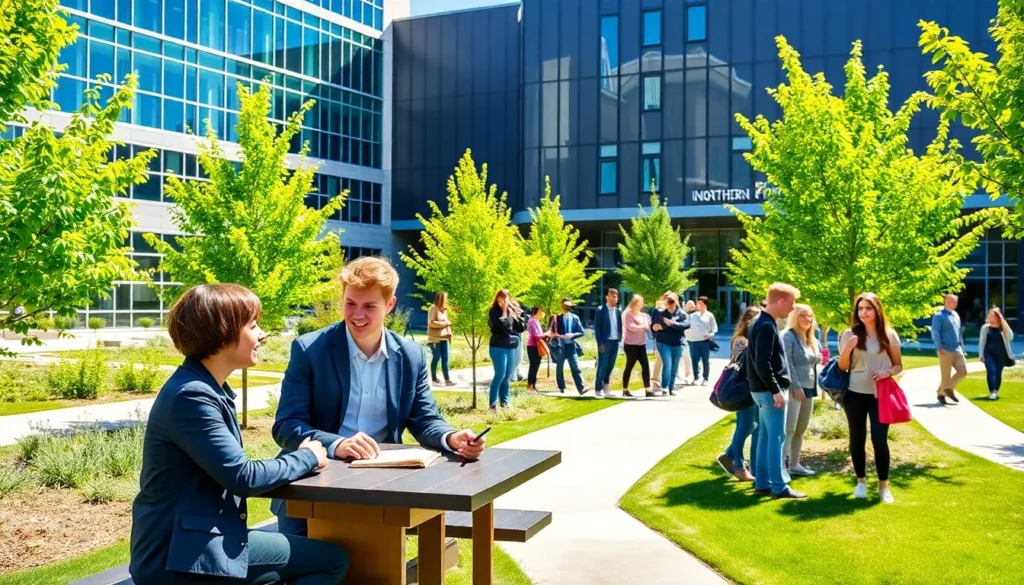Navigating the world of college housing can feel like trying to find a needle in a haystack—while blindfolded. With dorm rooms that resemble shoeboxes and off-campus apartments that seem to have been designed by a committee of raccoons, students often face a housing hunt that’s equal parts thrilling and terrifying. But fear not, this adventure can lead to the best memories and friendships that last a lifetime.
From cozy nooks to bustling shared spaces, finding the right college housing is crucial for academic success and social life. It’s not just about having a roof over one’s head; it’s about creating a home away from home. So grab your favorite snack and settle in, because this guide will help students navigate the quirky world of college housing, ensuring they find the perfect place to crash after those late-night study sessions (or epic Netflix binges).
Table of Contents
ToggleOverview of College Housing
College housing plays a crucial role in shaping a student’s academic and social environment. Finding suitable living arrangements significantly influences the overall college experience.
Importance of College Housing
College housing affects academic performance, social interactions, and personal well-being. Safe and comfortable accommodations foster productivity and enhance focus on studies. Access to resources, like libraries and study lounges, creates opportunities for collaboration. Additionally, proximity to campus activities encourages participation in social events. The right housing arrangement promotes a sense of belonging, crucial for student retention and satisfaction.
Types of College Housing
Students encounter several housing options during their college journey. Dormitories offer a communal living experience, often with shared facilities. Apartments provide independence, catering to those preferring private living spaces. Some campuses feature co-ops, where students share responsibilities and costs. Off-campus housing includes rentals, catering to diverse budgets and preferences. Each category presents unique benefits, allowing students to select environments that best support their needs.
Pros and Cons of Living On-Campus

Living on-campus offers unique opportunities and challenges for students. Analyzing these can help students make informed decisions about their housing options.
Advantages of On-Campus Living
Living on-campus fosters a strong sense of community, often leading to lasting friendships. Convenience ranks high, with easy access to classes, libraries, and dining facilities. Safety measures typically ensure peace of mind, as many campuses have security personnel and surveillance systems. Social activities abound, offering students the chance to engage with their peers and participate in events. Flexibility in meal plans often simplifies budgeting and meal preparation, allowing students to focus on academics instead.
Disadvantages of On-Campus Living
On-campus living can lead to limited privacy due to shared spaces with roommates. Costs may be higher compared to some off-campus options, impacting students’ finances. Noise levels can disrupt study habits, especially in vibrant dormitory settings. Rules and regulations imposed by housing authorities might restrict individual freedoms, making personal expression challenging. Meal options may not always cater to specific dietary needs, affecting overall satisfaction with dining experiences.
Pros and Cons of Living Off-Campus
Living off-campus offers students distinct advantages and disadvantages. Understanding these can help students make well-informed housing decisions.
Advantages of Off-Campus Living
Increased privacy often appeals to students seeking a quieter environment. More space typically allows for greater comfort, making it easier to study and relax. Greater flexibility in choosing roommates can result in a better living dynamic, catering to individual preferences. Additionally, students often enjoy the freedom to create a personalized living environment without strict regulations often found in dorms. Many off-campus locations also offer lower housing costs compared to campus housing, increasing budget flexibility. Proximity to local amenities such as grocery stores and cafes enhances convenience.
Disadvantages of Off-Campus Living
Off-campus living can create challenges in commuting to classes, potentially increasing travel time. Additional responsibilities, like managing bills and maintenance issues, may overwhelm some students. Safety concerns arise for those living farther from campus, making it crucial to assess neighborhood security. Limited access to campus resources, such as libraries and dining facilities, may hinder some students from fully engaging with campus life. Lastly, fewer social activities are available in off-campus settings, which can impact the sense of community that many students value.
Factors to Consider When Choosing College Housing
Choosing college housing involves several important factors. Each element can affect the overall college experience.
Location Considerations
Location greatly influences accessibility and convenience. Proximity to campus can minimize commute time, allowing more focus on studies. Housing near classes and libraries enhances academic productivity. Additionally, students find it beneficial to have nearby grocery stores, restaurants, and social venues. A safe neighborhood fosters peace of mind, which is crucial for well-being. Being part of a vibrant community can also enrich social interactions and participation in local events.
Budget and Affordability
Budget impacts housing choices significantly. Students should assess their financial resources, including tuition and living expenses. Many find on-campus options might have higher upfront costs but include utilities and meals. Off-campus housing might lower rental costs, although students must account for additional expenses like groceries and utilities. Creating a budget helps identify what’s affordable, ensuring housing remains financially manageable. Exploring different options allows students to make informed decisions about their living arrangements.
Amenities and Facilities
Amenities and facilities play a critical role in the decision-making process. Access to laundry facilities, study lounges, and recreational areas can enhance comfort and convenience. Many students prioritize private bathrooms and kitchen access for added privacy. Some housing options provide furnished rooms, reducing moving costs. Internet and cable service availability often influences choices, especially for those who require reliable connectivity for coursework. Evaluating available amenities helps students select housing that aligns with their lifestyle and academic demands.
Finding the right college housing can be a transformative experience for students. It shapes their academic journey and social life in profound ways. By carefully considering options and understanding the pros and cons of both on-campus and off-campus living, students can make choices that enhance their college experience.
Prioritizing location budget and amenities ensures that students select a space that fits their needs. A well-chosen living environment fosters productivity and encourages social connections. Ultimately a comfortable home away from home sets the stage for a successful and fulfilling college life.





